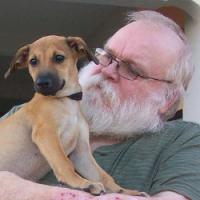LinuxCNC for possible use with G540/X-Carve
- netfoot
-
 Topic Author
Topic Author
- Offline
- New Member
-

- Posts: 7
- Thank you received: 0
Honestly, I don't expect to use the machine for very much other than running LinuxCNC itself, but that might involve reading G-Code off an NFS mounted filesystem, and it might involve streaming a video of progress to another system on the LAN. And there is every possibility I might want to pop open a browser and look something up or check for something online.
Please Log in or Create an account to join the conversation.
- ArcEye
- Offline
- Junior Member
-

- Posts: 22
- Thank you received: 239
. After about 10 minutes, the jitter numbers were: 4778 and 5310. From what I can gather, those numbers are acceptable.
Looks like a very suitable candidate for software stepping.
I would suggest you take up the offer of the configuration already in use by another user and once you are running can tweak and 'personalise' as you wish.
regards
Please Log in or Create an account to join the conversation.
- geoffs
- Offline
- Senior Member
-

- Posts: 41
- Thank you received: 6
Stepconf tells me the step rate is just over 40,000 steps/sec. (does that mean per axis or is it a total?)
Please Log in or Create an account to join the conversation.
- ArcEye
- Offline
- Junior Member
-

- Posts: 22
- Thank you received: 239
Stepconf tells me the step rate is just over 40,000 steps/sec. (does that mean per axis or is it a total?)
I haven't seen that, but then have not used stepconf for a long time.
The max number of steps is decided by the frequency of the thread and the step type.
Type 0 can run one step per 2 polls of make_pulses, maximum.
What is the BASE_THREAD = figure in your .ini file? ( [EMCMOT] section )
Please Log in or Create an account to join the conversation.
- geoffs
- Offline
- Senior Member
-

- Posts: 41
- Thank you received: 6
[EMCMOT]
EMCMOT = motmod
COMM_TIMEOUT = 1.0
COMM_WAIT = 0.010
BASE_PERIOD = 35283
SERVO_PERIOD = 1000000Please Log in or Create an account to join the conversation.
- ArcEye
- Offline
- Junior Member
-

- Posts: 22
- Thank you received: 239
www.linuxcnc.org/docs/devel/html/motion/...rs.html#_no_guessing
Need your stepper driver timings in addition to the max jitter figure.
You might be able to get your base-thread figure down near 30,000 depends upon the other factors, but if it runs OK and does not miss any steps, I would leave it alone
The figure is a total, the number of signals stepgen emits is not reliant upon how many axes are specified, all it does is shift a bit pin value for each axis, if that axis position_fb is less than position_cmd.
The stepper driver uses this to generate the actual step, so the timings of the driver are often a limiting factor.
regards
Please Log in or Create an account to join the conversation.
- geoffs
- Offline
- Senior Member
-

- Posts: 41
- Thank you received: 6
Not sure where this info is (.stepconf?) so here are all the config files for my setup.
Please Log in or Create an account to join the conversation.
- ArcEye
- Offline
- Junior Member
-

- Posts: 22
- Thank you received: 239
<property name="dirhold" type="float" value="700.0"/>
<property name="dirsetup" type="float" value="700.0"/>
<property name="stepspace" type="float" value="2500.0"/>
<property name="steptime" type="float" value="2500.0"/>
<property name="latency" type="float" value="16000.0"/>Those are the figures it is working with
Note however that the xyz-carve.hal file does not use the step timings just leaves them to be set by the thread speed, this is quite normal.
The dirhold and the dirsetup are longer than the figures you provided
setp stepgen.0.steplen 1
setp stepgen.0.stepspace 0
setp stepgen.0.dirhold 16700
setp stepgen.0.dirsetup 16700Please Log in or Create an account to join the conversation.
- geoffs
- Offline
- Senior Member
-

- Posts: 41
- Thank you received: 6
Please Log in or Create an account to join the conversation.
- ArcEye
- Offline
- Junior Member
-

- Posts: 22
- Thank you received: 239
Manufacturers sometimes use nanoseconds, sometimes microseconds and sometimes a mix
www.geckodrive.com/geckodrive-step-motor-drives/g540.html
If it works, I should leave it, the main values are the step ones and those are taken care of by stepconf using thread length.
The dirsetup etc might be able to be tweaked at bit, they do appear to be 8x higher than the Gecko spec sheet and over twice what you input.
You can try manually editing the hal and ini files when you are happy doing it.
Please Log in or Create an account to join the conversation.
